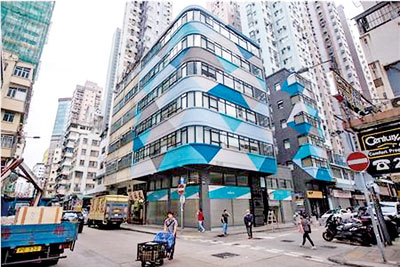Tight squeeze for Hong Kong’s young professionals
View(s):HONG KONG, AFP June 13 – As housing prices spiral in Hong Kong, young professionals are living in ever-shrinking spaces, with box-like “nano-flats” and co-shares touted as fashionable solutions.

General view of a co-sharing building where residents can rent a small living space in the Mong Kok district of Hong Kong.
Blocks of sleek miniature apartments packed with mod cons are springing up around the densely packed city, pitched as an attractive and more affordable lifestyle choice, but still at an eye-watering cost.
Finance worker Adrian Law, 25, paid more than HK$6 million (US$765,000) two years ago for his tiny studio apartment in a new development in the gentrified Sai Ying Pun neighbourhood.
The slim glass building squeezes four apartments onto each floor and includes “nano-flats”, a new term for homes of under 215 square feet (20 square metres).
Law’s studio is a fraction bigger at 292 square feet, with a price per square foot of nearly HK$20,000.
He has adapted to the limited space by buying transformable furniture — his bed folds away against the wall to reveal a desk tucked underneath — and he keeps most of his belongings at his parents’ home.
But with a fingerprint-activated door lock, washing machine, TV, fridge and even curtains, Law says the flat came with everything he needed.
“Property developers are marketing the concept to buyers that they only need a place to sleep and can do anything else outside,” he told AFP, admitting he eats mostly take-away food as the kitchen is too small for cooking.
Law’s parents helped him put down a 30 per cent deposit when he bought the apartment and he sees it as an investment. He pays HK$24,000 per month for the mortgage, around 40 per cent of his salary.
“One can only get into a winning position by owning a place,” he said. “If you’re renting, you are spending all your money without gaining anything at the end.”
Health threat
Hong Kong’s real estate is the most expensive in the world, with median house prices at 19.4 times median incomes — the worst ratio globally according to the Annual Demographia International Housing Affordability Survey 2018.
Property prices have been fuelled by an influx of money from wealthy mainland Chinese investors and developers, and the city government stands accused of failing to control the red-hot property market.
More than 60 per cent of new flats under 430 sq ft are taken up by investment buyers, according to government figures.
With the ability to buy a flat increasingly out of reach for the majority of Hong Kong’s 7.4 million residents, developers are creating smaller spaces to reach a wider market.
Under Hong Kong law there is no limit to how small a flat can be.
Ryan Ip, senior researcher at public policy think tank Our Hong Kong Foundation, describes it as an “unhealthy” trend with developers putting profit above quality of life.
“If you count the per-square-foot price for smaller-size flats, it is even higher than larger flats,” said Ip, who believes mental and physical health will suffer if properties continue to shrink.
Rental prices have also rocketed and the wait for government-subsidised public housing can be five years.
Ip says expanding land supply by any means, including reclamation from the sea, is the only way to solve the affordable housing shortage.
But other local land research groups argue Hong Kong should develop under-utilised brownfield sites and idle government land first.
The government is considering a host of options, from new artificial islands to developing the city’s cherished country parks.
Designers are also putting forward their own new concepts, including converting concrete pipes into living spaces and transforming shipping containers into homes.
Sharing space
Many poorer Hong Kong residents resort to renting dingy “subdivided” flats — apartments carved up into multiple living spaces.
But even for those on a good salary, a decent home is often unaffordable.
Jezz Ng, 29, earns a monthly wage of HK$32,000 as a teacher and has chosen to live in a new co-share housing set-up, rather than shelling out for her own rent. At weekends she goes home to her parents.
Ng shares a unit with seven other women where she has her own small room, which can fit a single bed and a desk.
Housed in a revitalised residential building in the working class neighbourhood of Yau Ma Tei, privately owned Bibliotheque offers 166 bed spaces across 15 units, with monthly rents ranging from HK$3,500 to HK$6,200.
All tenants have access to communal facilities, from shower areas and a kitchen to activity rooms and study rooms.
“When I started to look for places to rent, my maximum budget was $8,000 including utilities, but a simple, decent studio room could easily go over this price,” Ng told AFP.
She now pays $5,600 per month, which she says allows her to support her parents financially and pay her sister’s tuition fees for a master’s degree — a common practice for young adults who are working.
Ng adds she feels less cramped than when she lived at home.
Founder of the co-share, Keith Wong, says it is designed for young professionals who need time to “accumulate wealth” by limiting their outgoings.
For now it is an ideal solution, says Ng.
“I want to strive for an apartment, but at the moment, there’s no way for me to achieve that goal,” she explained.
“Even though I have a stable job and the salary goes up steadily, it will never catch up with the increase in property prices. “


